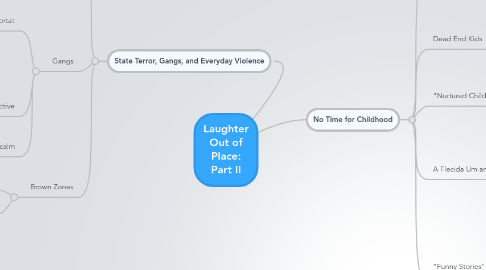
1. State Terror, Gangs, and Everyday Violence
1.1. Crime and Violence in Rio de Janeiro
1.1.1. Middle/upper class crime vs working class crime
1.1.2. New node
1.2. Gangs
1.2.1. Role in Favela viewed as importat
1.2.1.1. power brokers
1.2.1.2. local protection
1.2.1.3. drug selling controlled
1.2.1.4. provide badly needed services
1.2.2. Seductive
1.2.2.1. place of belonging
1.2.2.2. decent "wages"
1.2.3. Cycles of violence and relative calm
1.2.3.1. changing of gang leader
1.3. Brown Zones
1.3.1. Attempt to hide impoverished areas
1.3.2. State unable to enforce legality
2. No Time for Childhood
2.1. Pedro Paulo (Gloria)
2.1.1. The Red Command
2.1.2. Refusal to earn Brazilian min. wage
2.1.3. Knew there was no social mobility for someone of his class
2.2. Dead End Kids
2.2.1. Death squads
2.2.2. Street children slain to reduce growing violence
2.3. "Nurtured Child" vs "Nurturing Child"
2.3.1. MIddle class vs poor
2.3.2. Parentified children
2.4. A Flecida Um and A Falecida Dois (Gloria)
2.4.1. "The first deceased" and "the second deceased"
2.4.2. Children banished from household
2.4.3. No longer considered children and only cause trouble
2.5. "Funny Stories" About Pain and Tragedy (Gloria)
2.5.1. Defecatin in bed= eating your own excrement
2.5.2. Bed-wetting= wearing urine stained bed sheet in public
2.5.3. Harsh discipline to keep children out of prison and alive
2.5.4. "Death without weaping"
